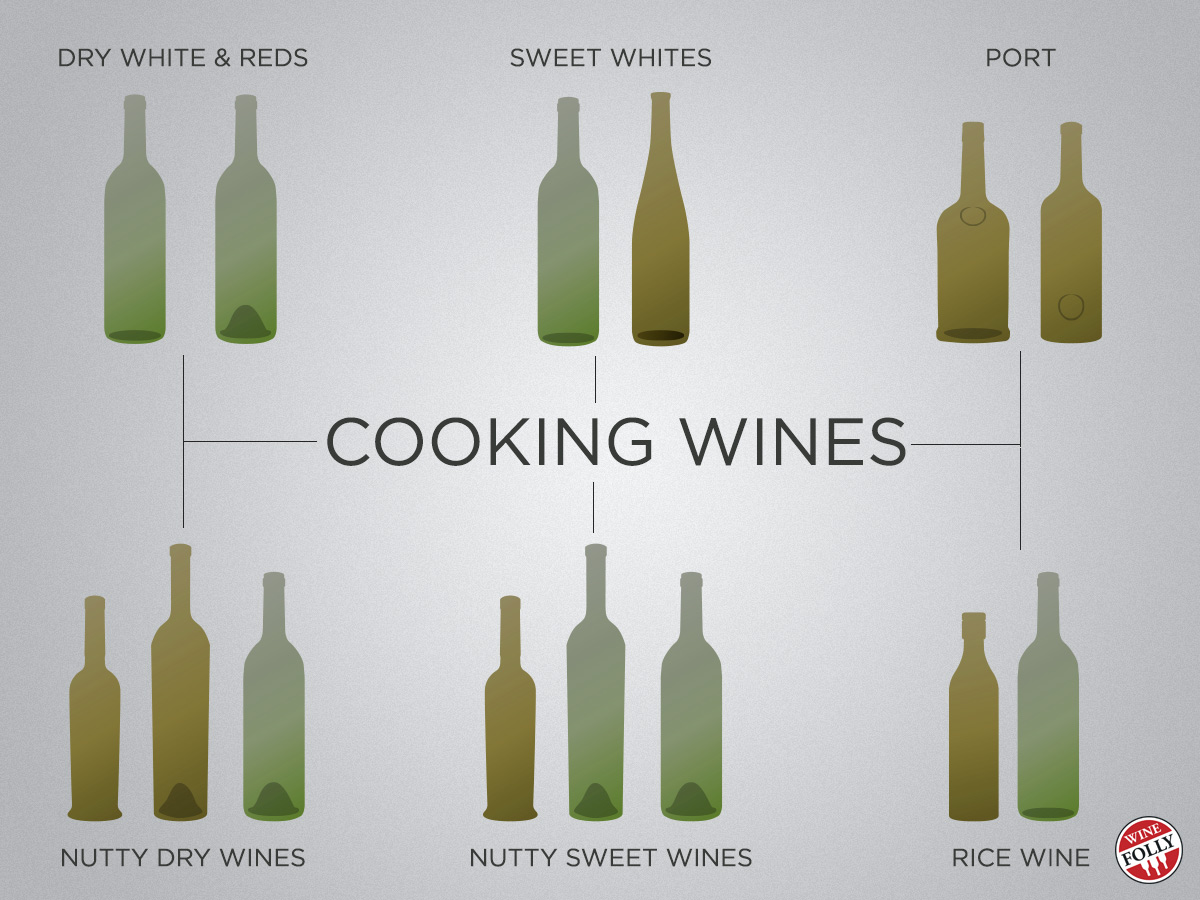There are several types of cooking wines including Marsala, Sherry, Sauternes and Rice Wine. This guide is designed to quickly identify the types of cooking wines and in what dishes they’re used.
Just so you know, the major difference between wines sold as cooking wines vs. regular drinking wines is quality. If anything, cooking with a regular drinking wine will give you a better tasting dish because the quality is much higher.
There are 6 main styles of cooking wine.
- 1. Dry Red & White Wines
- 2. Dry Nutty/Oxidized Wines
- 3. Sweet Nutty/Oxidized Wines
- 4. Sweet Fortified Red Wines Like Port
- 5. Sweet White Wines
- 6. Rice Wine
How to Choose a Cooking Wine
Dry Red & White Wines
Perfect for using with beef stews, cream soups, mussels, clams and wine-based sauces.
Dry white and red wines fall into the category of regular drinking wines. The best wine to use in your dish will often be one that will pair well with your meal. Dry red wines are best used for sauces such as Wine Reduction Sauce, Bourguignonne Sauce and Beurre Rouge. Dry white wines are used for everything from cream sauces, soups and to deglaze your pan. See the complete guide on dry white wine for cooking.
Dry Nutty/Oxidized Wines
Perfect for mushroom gravies on chicken and pork chop, rich fish like halibut and shrimp.
Each oxidized wine has a uniquely different taste that will change the flavor profile of the dish. For example, a Rainwater Madeira really can’t be a substitute in a recipe that calls for Marsala. Most of these wines are higher ABV, which means they add a richer taste to a dish than a dry wine. They typically last for a couple of months open, especially when you store them in your refrigerator. Try them all if you can and pick your favorite to use on a regular basis.
- Marsala
- Madeira
- Dry Sherry
- Oloroso Sherry
- Vermouth
- Vin Jaune
Sweet Nutty/Oxidized Wines
Perfect for syrups on desserts with nuts, caramel, and vanilla ice cream.
This style of wine is almost always aged for a minimum of 10 years and the better, more viscous examples for nearly 40 years before opening. These wines can be reduced a little to create a rich caramel-like sauce or, in some cases, can just be poured over your dessert. These wines can last about a month or so open in your fridge.
- Tawny Port
- Vin Santo
- Cream Sherry
- Pedro Ximinez (PX)
- Malvasia
- Italian Passito Wines
Sweet Fortified Red Wines (Port)
Perfect for chocolate sauces, chocolate cakes, Port reduction syrup, and savory Port sauces for steaks with blue cheese.
Red Ports include Ruby Port, Late-Bottled Vintage Port, and Vintage Port. Ruby Port is a great everyday solution for cooking because it’s the most affordable. Keep a bottle around! Ruby Port will keep for a month or two, and it’s awesome as a sauce on top of brownies, cakes, and even on steak.
Sweet White Wines (Sauternes)
Perfect for poaching pears, sweet sauces for fruit tarts, and faintly sweet butter sauces for flaky fish, lobster, and shrimp.
These delicately flavored, high acidity sweet white wines can be used both for desserts and delicately flavored sweet and savory fish dishes. This style of wine is typically sensitive to light and air, so it’s a good idea to plan to use or drink the entire bottle once you open it.
- Sauternes
- Late Harvest Whites
- Sweet Riesling
- Moscato
- Ice Wine
- Gewürztraminer
Rice Wine
Perfect for Marinades, Glazes, and Asian BBQ Sauce.
There are 2 types of rice wines available: Chinese and Japanese rice wine. The Chinese/Taiwanese style isn’t technically a ‘wine’ because it has to be distilled to reach an ABV of 35 percent. Chinese rice ‘wine’ is used to add acidity to stir fries. The other style is a Japanese rice wine called Mirin. Mirin used to be served as a drinking aperitif but is now only readily available commercially (i.e. lower quality). Mirin has an ABV of about 8-12% and is salty-sweet; it’s perfect for glazes and Asian BBQ sauce.


